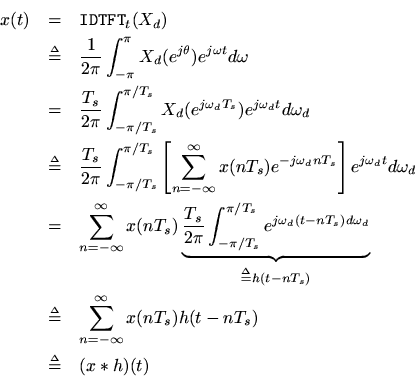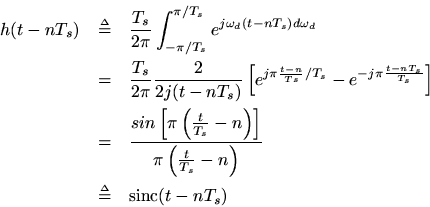NOTE: THIS DOCUMENT IS OBSOLETE, PLEASE CHECK THE NEW VERSION: "Mathematics of the Discrete Fourier Transform (DFT), with Audio Applications --- Second Edition", by Julius O. Smith III, W3K Publishing, 2007, ISBN 978-0-9745607-4-8. - Copyright © 2017-09-28 by Julius O. Smith III - Center for Computer Research in Music and Acoustics (CCRMA), Stanford University
<< Previous page TOC INDEX Next page >>
Shannon's Sampling TheoremTheorem. Let
denote any continuous-time signal having a continuous Fourier transform
Let
denote the samples ofat uniform intervals of
seconds. Then
can be exactly reconstructed from its samples
if and only if
for all
.A.1
Proof. From the Continuous-Time Aliasing Theorem of §A.2, we have that the discrete-time spectrum
can be written in terms of the continuous-time spectrum
as
whereis the ''digital frequency'' variable. If
for all
, then the above infinite sum reduces to one term, the
term, and we have
At this point, we can see that the spectrum of the sampled signalcoincides with the spectrum of the continuous-time signal
. In other words, the DTFT of
is equal to the FT of
between plus and minus half the sampling rate, and the FT is zero outside that range. This makes it clear that spectral information is preserved, so it should now be possible to go from the samples back to the continuous waveform without error.
To reconstruct
from its samples
, we may simply take the inverse Fourier transform of the zero-extended DTFT, i.e.,
By expandingas the DTFT of the samples
, the formula for reconstructing
as a superposition of sinc functionsweighted by the samples, depicted in Fig. A.1, is obtained:
where we defined
I.e.,
The ''sinc function'' is defined within its argument so that it has zero crossings on the integers, and its peak magnitude is 1. Figure A.2illustrates the appearance of the sinc function.
We have shown that when
is band-limited to less than half the sampling rate, the IFT of the zero-extended DTFT of its samples
gives back the original continuous-time signal
.
Conversely, if
can be reconstructed from its samples
, it must be true that
is band-limited to
, since a sampled signal only supports frequencies up to
(see §A.4). This completes the proof of Shannon's Sampling Theorem.
A ''one-line summary of Shannon's sampling theorem is as follows:
That is, the Discrete-Time Fourier Transform of the samples is extended to plus and minus infinity by zero, and the inverse Fourier transform of that gives the original signal. The Continuous-TimeAliasing Theorem provides that the zero-paddedand
are identical, as needed.
Shannon's sampling theorem is easier to show when applied todiscrete-time sampling-rate conversion, i.e., when simple decimationof a discrete time signal is being used to reduce the sampling rate by an integer factor. In analogy with the Continuous-Time Aliasing Theorem of §A.2, the Decimation Theorem states thatdownsampling a digital signal by an integer factor
produces a digital signal whose spectrum can be calculated by partitioning the original spectrum into
equal blocks and then summing (aliasing) those blocks. If only one of the blocks is nonzero, then the original signal at the higher sampling rate is exactly recoverable.




